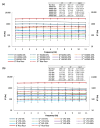Enrichment of Rice Flour with Almond Bagasse Powder: The Impact on the Physicochemical and Functional Properties of Gluten-Free Bread
- PMID: 40647134
- PMCID: PMC12249467
- DOI: 10.3390/foods14132382
Enrichment of Rice Flour with Almond Bagasse Powder: The Impact on the Physicochemical and Functional Properties of Gluten-Free Bread
Abstract
Almond bagasse, a by-product of almond milk production, is rich in fibre, protein, polyunsaturated fatty acids, and bioactive compounds. Its incorporation into food products provides a sustainable approach to reducing food waste while improving nutritional quality. This study explored the impact of enriching rice flour with almond bagasse powders-either hot air-dried (HAD60) or lyophilised (LYO)-at substitution levels of 5%, 10%, 15%, 20%, 25%, and 30% (w/w), to assess effects on gluten-free bread quality. The resulting flour blends were analysed for their physicochemical, techno-functional, rheological, and antioxidant properties. Gluten-free breads were then prepared using these blends and evaluated fresh and after seven days of refrigerated storage. The addition of almond bagasse powders reduced moisture and water absorption capacities, while also darkening the bread colour, particularly in HAD60, due to browning from thermal drying. The LYO powder led to softer bread by disrupting the starch structure more than HAD60. All breads hardened after storage due to starch retrogradation. The incorporation of almond bagasse powder reduced the pasting behaviour-particularly at substitution levels of ≥ 25%-as well as the viscoelastic moduli of the flour blends, due to fibre competing for water and thereby limiting starch gelatinisation. Antioxidant capacity was significantly enhanced in HAD60 breads, particularly in the crust and at higher substitution levels, due to Maillard reactions. Furthermore, antioxidant degradation over time was less pronounced in formulations with higher substitution levels, with HAD60 proving more stable than LYO. Overall, almond bagasse powder improves the antioxidant profile and shelf-life of gluten-free bread, highlighting its value as a functional and sustainable ingredient.
Keywords: almond bagasse powder; antioxidant properties; bread; flour; food waste; hot air-drying; lyophilised; rheological properties; storage; techno-functional properties.
Conflict of interest statement
The authors declare no conflicts of interest.
Figures







Similar articles
-
The Use of Whey Powder to Improve Bread Quality: A Sustainable Solution for Utilizing Dairy By-Products.Foods. 2025 Aug 21;14(16):2911. doi: 10.3390/foods14162911. Foods. 2025. PMID: 40870823 Free PMC article.
-
Gluten-Associated Medical Problems.2025 Jun 20. In: StatPearls [Internet]. Treasure Island (FL): StatPearls Publishing; 2025 Jan–. 2025 Jun 20. In: StatPearls [Internet]. Treasure Island (FL): StatPearls Publishing; 2025 Jan–. PMID: 30860740 Free Books & Documents.
-
The effect of fruit pomace addition on the color, texture and sensory properties of gluten-free bread.Sci Rep. 2025 Jul 8;15(1):24510. doi: 10.1038/s41598-025-10077-z. Sci Rep. 2025. PMID: 40628932 Free PMC article.
-
Systemic pharmacological treatments for chronic plaque psoriasis: a network meta-analysis.Cochrane Database Syst Rev. 2021 Apr 19;4(4):CD011535. doi: 10.1002/14651858.CD011535.pub4. Cochrane Database Syst Rev. 2021. Update in: Cochrane Database Syst Rev. 2022 May 23;5:CD011535. doi: 10.1002/14651858.CD011535.pub5. PMID: 33871055 Free PMC article. Updated.
-
Systemic pharmacological treatments for chronic plaque psoriasis: a network meta-analysis.Cochrane Database Syst Rev. 2017 Dec 22;12(12):CD011535. doi: 10.1002/14651858.CD011535.pub2. Cochrane Database Syst Rev. 2017. Update in: Cochrane Database Syst Rev. 2020 Jan 9;1:CD011535. doi: 10.1002/14651858.CD011535.pub3. PMID: 29271481 Free PMC article. Updated.
References
-
- Garcia-Perez P., Xiao J., Munekata P.E.S., Lorenzo J.M., Barba F.J., Rajoka M.S.R., Barros L., Mascoloti Sprea R., Amaral J.S., Prieto M.A., et al. Revalorization of Almond By-Products for the Design of Novel Functional Foods: An Updated Review. Foods. 2021;10:1823. doi: 10.3390/foods10081823. - DOI - PMC - PubMed
-
- Ramírez-Pulido B., Bas-Bellver C., Betoret N., Barrera C., Seguí L. Valorization of Vegetable Fresh-Processing Residues as Functional Powdered Ingredients. A Review on the Potential Impact of Pretreatments and Drying Methods on Bioactive Compounds and Their Bioaccessibility. Front. Sustain. Food Syst. 2021;5:654313. doi: 10.3389/fsufs.2021.654313. - DOI
Grants and funding
LinkOut - more resources
Full Text Sources

